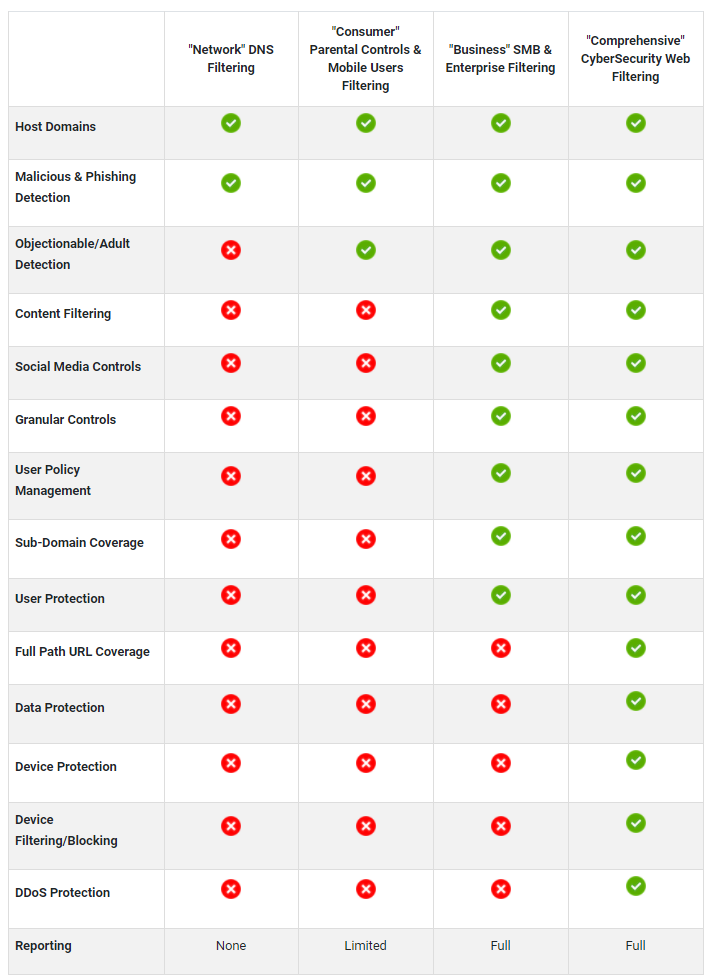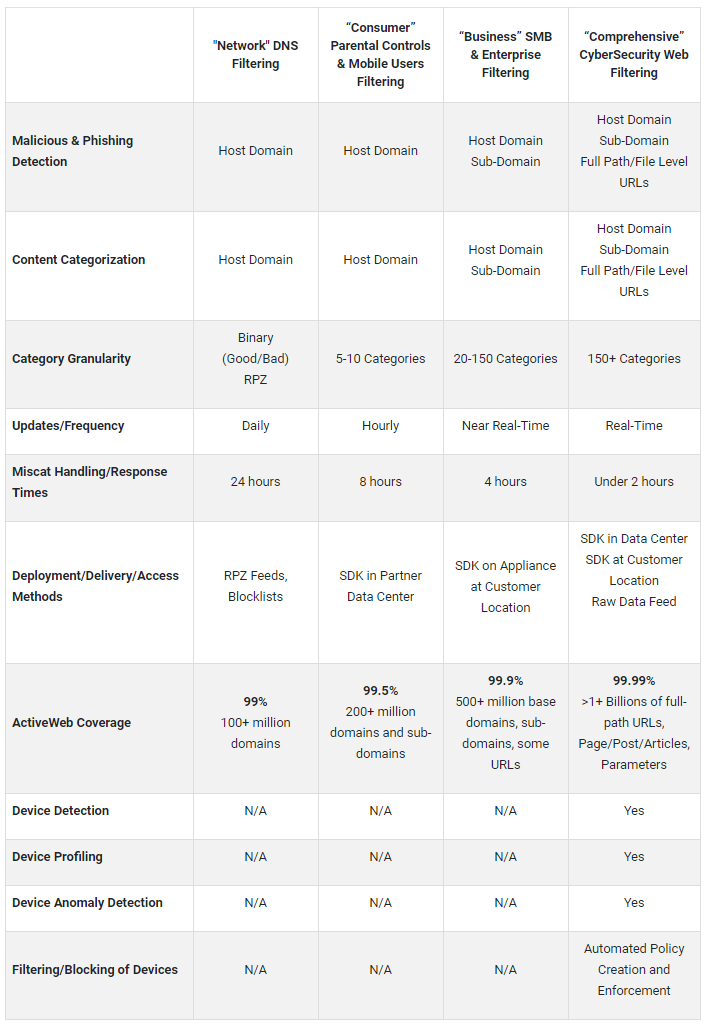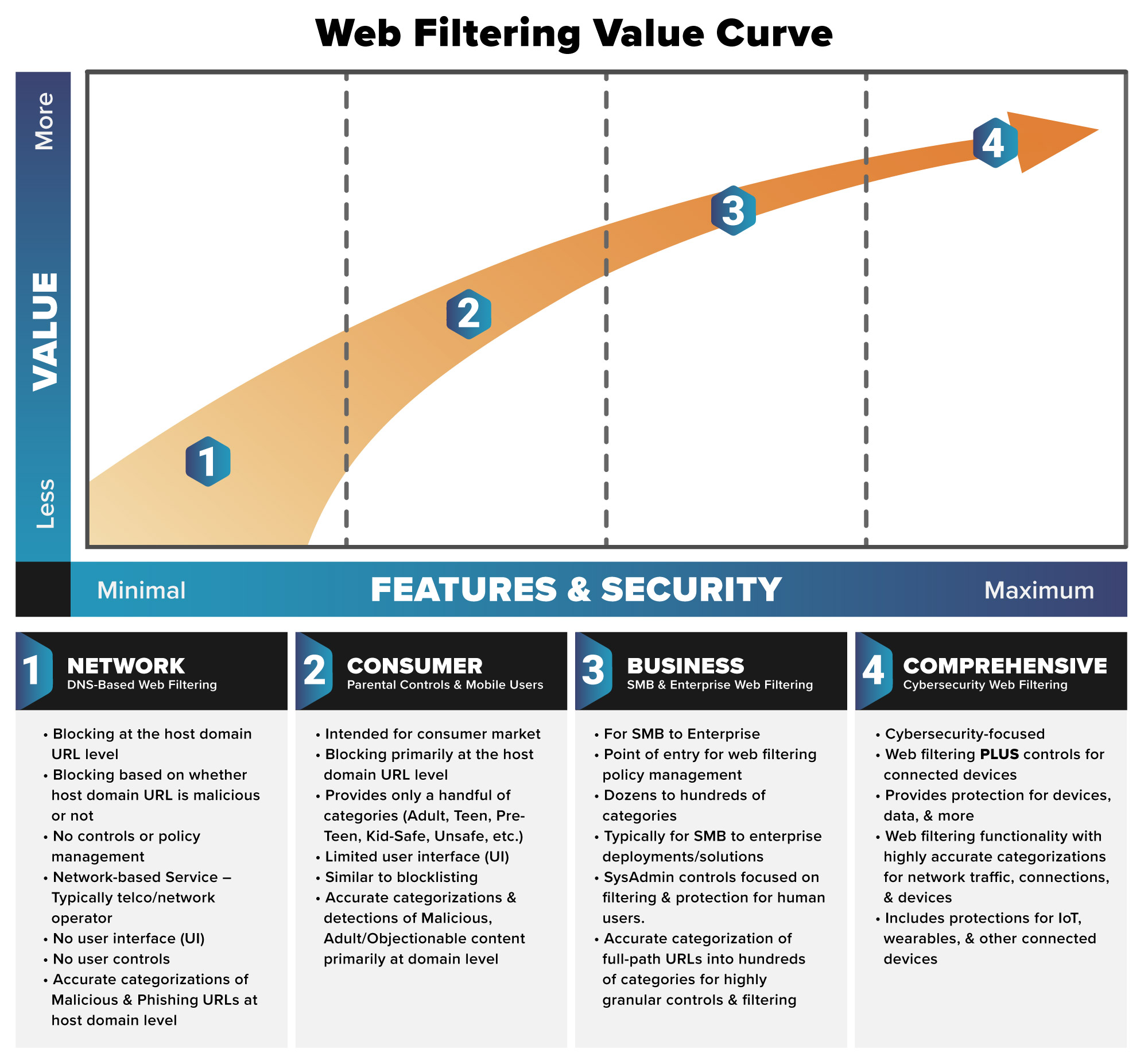Estimated Reading Time: 5 minutes
As we strive to provide the market’s most accurate and comprehensive URL database, we find ourselves in discussions with prospective partners with a wide range of “web filtering” use cases. At times, it’s unclear to them (or us) where their contemplated offering falls on the web filtering value spectrum, the market they are targeting with their offering and how they envision differentiating the offering.
The purpose of this article is to provide a quick and easy visual reference the web filtering market segments and to identify where various services are positioned in the market and on the value curve.
Web Filtering Market Segments
In some ways, the web filtering market is no different than the auto industry, where some manufacturers target a mass market with a vehicle with limited features and capabilities. There may be more competition and challenges differentiating the different makes and models, but there are a significant number of consumers for vehicles in this “commodity” market. On the other end of the value spectrum, there are exotic or highly specialized vehicles, with considerably more features and better performance. The number of prospective consumers may be smaller, however, the vehicles command a significantly higher price point. Some auto manufacturers focus on a single market segment, while others have models across multiple market segments.
The web filtering market landscape is very similar, with some companies that target a low-priced, no frills, minimal protection market that emphasizes price over functionality, to companies that focus on the family or mobile user markets where price is still a primary decision criteria yet a minimal amount of protection is desired, to companies that focus on the SMB and Enterprise business markets where features, functionality, and protection start to take precedence over strictly price in the decision, to the high end “supercars” of the web filtering world that have outstanding security and protections for the most demanding markets, where customers want to protect not only users, but also all of the web-connected devices and data on their networks. There are companies that focus on a single market segment, while others have services that span multiple market segments.
In some ways, the zveloDB™ URL Database is analogous to the companies that provide engines to the various car manufacturers. The zveloDB is flexible enough to be configured and used as the “engine” in everything from the minimally-featured, mass-market DNS and web filtering offering to the high-performance, supercars of the web filtering and cybersecurity world.
We have attempted to organize the web filtering value curve using factors such as the relative ARPU (Average Revenue per User), the richness of features, as well as the size of the markets in terms of users.
Web Filtering Product Roadmap and Evolution
In discussions with partners and prospects, we frequently are engaged in supporting the development of product roadmaps, which requires a deep understanding of the market differentiators, why and how users adopt new offerings, and more.
In nearly every instance, we are seeing partners increasingly focusing their efforts on moving “up the value curve”, which in reality means adding more capabilities, improving the user experience, and increasing protections from “user-based” offerings that are focused on primarily protecting the human user from surfing to dangerous or inappropriate websites, to also include protecting data and “things” that aren’t human-centric, such as IoT and other web-connected devices that pose risks from hacking, DDoS, and privacy theft.
The process of moving up/along the value curve may also establish the product roadmap and development priorities for web filtering vendors.
The benefits to the web filtering provider are increased ARPU, reduced churn, improved value leadership and more. The further up the value curve, the greater the emphasis on the capabilities of the underlying URL database and categorization services, which we cover below and in other articles.
The X’s and O’s of the Web Filtering Markets
The Web Filtering landscape, like many markets, doesn’t fit neatly into a well-defined market segments. However, we have attempted to organize the various offerings into the four most common services which we hear described by prospects and partners.
The most common services for which we are engaged to integrate the zveloDB include:
- “Network” – DNS Filtering
- “Consumer” – Parental Controls/Mobile Filtering
- “Business” – SMB & Enterprise Business Web Filtering
- “Comprehensive” – Total Cybersecurity Web Filtering
These services may be given different names by different companies and people, however, we have identified/grouped the services based on the features they provide, as follows.

URL Database and Categorization Requirements
Importantly, how does this translate into the requirements for a URL database and categorization services? We’ve outlined below the requirements and expectations we experience from partners in these various markets.

The Web Filtering Value Curve
Finally, here is the Web Filtering Value Curve, reflecting the positioning of the various web filtering services across the value spectrum.

Summary
Understanding the market on which an offering is focused helps to identify the features, functionality, URL database, reporting, user experience and other requirements, as well as opportunities to target adjacent markets, which in turn contributes to product planning and marketing efforts.
This knowledge will also lead to proper vendor selection for the URL database, the types of detection and categorization services you require today and in the future, and help to build the type of long-term relationships which will play a big role in your success.





